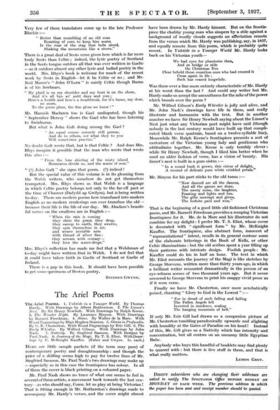The Ariel Poems
The Ariel Poems. 1. Yuletide in a Younger World. By Thomas Hardy. With Drawings by Albert Rutherston. 2. The Linnet's Nest. By Sir Henry Newbolt. With Drawings by Ralph Keene. 3. The Wonder Night. By Laurence Binyon. With Drawings by Barnett Freedman. 4. Alone. By Walter de la Mare. With Wood Engravings by Blair Hughes-Stanton. 5. Gloria in Profundis. By G. K. Chesterton. With Wood Engravings by Eric Gill. 6. The Early Whistler. By Wilfred Gibson. With Drawings by John Nash. 7. Nativity. By Siegfried Sassoon. With Designs by Paul Nash. 8. Journey of the Magi. By T. S. Eliot. With Draw- ings by E. McKnight Kauffer. (Faber and Gwyer. Is. each.) HERE are little sample packets (if the term may pass) of contemporary poetry and draughtmanship : and though the price of a shilling seems high to pay for twelve lines of Mr. Siegfried Sassoon, Mr. Paul Nash's two drawings may make up —especially as in this case the frontispiece has colour. In all
of them the cover is black printing on a coloured paper.
Mr. Paul Nash shows no trace Of what one seems to feel in several of these artists, a movement back towards the last cen- tury—as who should say, Come, let us play at being Victorian That is fitting enough in Mr. Rutherston's drawings made to accompany Mr. Hardy's verses, and the cover might almost
have been drawn by Mr. Hardy himseir. But on the frontis- piece the chubby young man who simpers by a stile against a background of woolly clouds suggests an affectation remote from the verses which Mr. Hardy was publishing, say, in 1857, and equally remote from this poem, which is probably quite recent. In Yuletide in a Younger World Mr. Hardy looks back on his Victorian youth— We had eyes for phantoms then.
And at bridge or stile On Christmas Eve Clear beheld those countless ones who had crossed it Cross again in file : Such has ceased longwhile.
Was there ever a line more entirely characteristic of Mr. Hardy at his worst than the last ? And could any writer but Mr. Hardy make us accept the uncouthness for the sake of the power which broods over the poem ?
Mr. Wilfred Gibson's Early Whistler is jolly and alive, and Mr. John Nash's drawings have life in them, and really illustrate and harmonize with the text. But in another number we have Sir Henry Newbolt saying about the Linnet's Nest just what any Victorian poet might have said (though nobody in the last century would have built up that compli- cated blank verse quatrain, based on a twelve-syllable line). Meanwhile Mr. Ralph Keene's frontispiece presents a sort of caricature of the Victorian young lady and gentleman who attitudinize together. Mr. Keene is only terribly clever : while Sir Henry Newbolt, though I liked him better when he used an older fashion of verse, has a vision of beauty. His linnet's nest is built in a gum cistus
" In a round bush it grows, this cistus of delight, A mound of delicate pure white crinkled petals."
Mr. Binyon for his part sticks to the old tunes :—
"Now danced are all the dances, And all the games are done, The merry noise, the laughter, Feasting and lights and fun. The gifts unwrapt and given, The forfeits paid and won."
That is the beginning of a good little old-fashioned Christmas poem, and Mr. Barnett Freedman provides a romping Victorian frontispiece .for it. Mr. de in Mare and his illustrator do not combine for my delight : I prefer Mr. T. S. Eliot, whose cover is decorated with " significant form " by Mr. McKnight Kauffer. The frontispiece, also abstract form, innocent of " representational " intent, recalls in its general contour some of the elaborate letterings in the Book of Kells, or other Celtic illuminations : but the old scribes spent a year filling up their patterns with intricate design. Foolish people : Mr. Kauffer could do his in half an hour. The text in which Mr. Eliot recounts the journey of the Magi is like sketches by George Steevens, written more than thirty years ago, in which a brilliant writer recounted dramatically in the person of an eye-witness scenes of two thousand years ago. But it never occurred to George Steevens to print his snappy vivid prose as if it were verse.
Finally we have Mr. Chesterton, once more acrobatically poised, chanting " Glory to God in the Lowest " :-
" For in dread of such falling and failing
The Fallen Angels fell Inverted in insolence, scaling The hanging mountain of helL"
If only Mr. Eric Gill had drawn us a companion picture of Mr. Chesterton tumbling paradoxically upwards and alighting with humility at the Gates of Paradise on his head ! Instead of this, Mr. Gill gives us a Nativity which has intensity and concentration, but all centres on an uncanny little Egyptian Babe.
Anybody who buys this handful of booklets may find plenty to quarrel with : but there is live stuff in them, and that is what really matters.
LEMON GREY.










































 Previous page
Previous page